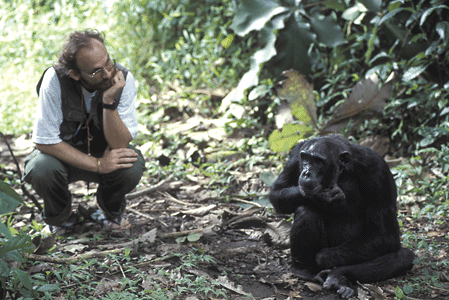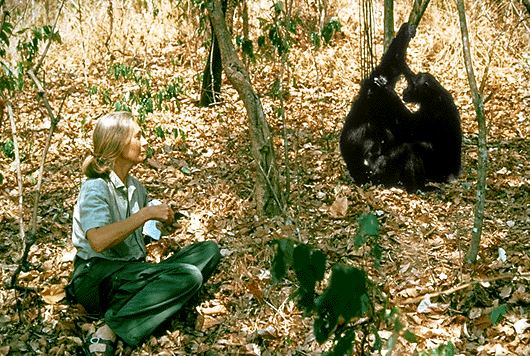Chimpanzee Warfare
Thursday, September 18th, 2014September 18, 2014
Chimpanzees share many physical and behavioral characteristics with human beings, including warfare, according to research published by Harvard primatologist Richard Wrangham and his colleagues in September in the journal Nature. The scientists argue that organized lethal violence between chimpanzee communities occurs for much the same reason that warfare is believed to occur between human societies.

A scientist who studies primates—an order of mammals that includes humans, apes, monkeys, and lemurs—observes a chimpanzee in its natural habitat. Chimpanzees share many behavioral characteristics with human beings. (© Gunter Ziesler from Peter Arnold, Inc.)
In the wild, chimpanzees form loosely tied groups called communities, which share the same territory. Within communities, the apes travel in smaller groups that vary in number and change members frequently. Biologists began studying the behavior of wild chimpanzees extensively beginning in the 1960’s. British zoologist Jane Goodall made some of the most important chimpanzee studies while working in northwestern Tanzania. Goodall was the first scientist to document lethal violence among chimpanzees.

Jane Goodall, a British zoologist, uncovered many similarities between human beings and chimpanzees through years of observation. (Breese, Gamma/Liaison)
The Harvard researchers analyzed data from 152 recorded instances where chimpanzees were killed by other chimpanzees over 426 combined years of scientific observation at 18 communities in Africa. They found that intercommunity violence among chimpanzee groups varied considerably. However, when violence did occur, the majority of deadly attacks were committed by males against other males of a neighboring community. An average attack included 8 adult males from one community killing a single isolated rival male. This suggests that chimpanzee males will only attack when they have an overwhelming numerical advantage that minimizes risk to themselves.
Importantly, the researchers observed that intercommunity attacks did not correlate with other factors thought to affect levels of violence and aggression in social animals. Other primatologists have theorized that chimpanzee violence originates from the stresses of human encroachment on chimpanzee habitat, illegal poaching, deforestation, and even researchers themselves supplying bananas at some sites. All of these factors were thought to promote aberrant behavior in the animals. Wrangham and his colleagues concluded that chimpanzee intercommunity violence is a natural adaptation for the apes that expands their territory and improves a groups’ access to food and other important resources, including mates, at the expense of another group.
Many scholars believe that organized warfare emerged in human history between 8,000 and 6,000 B.C. At this time, the development of settled agricultural civilizations created both riches and scarcity. There was wealth that people could protect and wealth that they could take from others. Families fought against families, and tribes fought against tribes. However, this new research suggests that the roots of warfare stretch back deep into the reaches of our primate ancestry.
Other World Book articles:


